Position: Full sun to dappled shade
Flowering period: Late spring to early summer
Soil: Moist, well drained
Eventual Height: 70cm
Eventual Spread: 50cm
Hardiness: 5a, 5b, 6a, 6b, 7a, 7b, 8a, 8b, 9a
Family: Ranunculaceae
Ranunculus lanuginosus is a medium height herbaceous perennial. Its mid green leaves are palmate with up to five lobes, have double serrate margins and are up to 12cm long and 8cm broad. Its stems are covered in fine hairs. Its yellow hermaphrodite flowers are regular, up to 3cm across and appear above the foliage on elongated stems. Its fruit is an achene.
Ranunculus lanuginosus, commonly known as Wooly Buttercup, is native to central and eastern Europe. In its native habitat it grows in moist and shady location in and around forests, particularly Beech. Ranunculus lanuginosus is synonymous with Ranunculus umbrosus.
The etymological root of the binomial name Ranunculus is derived from the Latin rana meaning ‘frog’, in reference to the plants liking for damp places. Lanuginosus is derived from the Latin lanugo meaning ‘downy’, in reference to its hairy stems.
The landscape architect may find Ranunculus lanuginosus useful as part of a woodland understory planting scheme.
Ecologically, Ranunculus lanuginosus is attractive to pollinating insects.
Ranunculus lanuginosus prefers moist, fertile, well-drained soils. It tolerates most pH of soil, although it prefers calcareous soils.
Ranunculus lanuginosus requires little maintenance.






Leave a comment